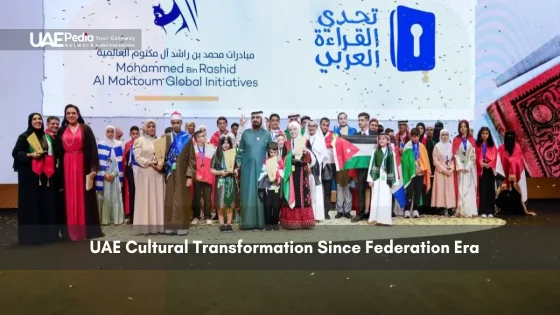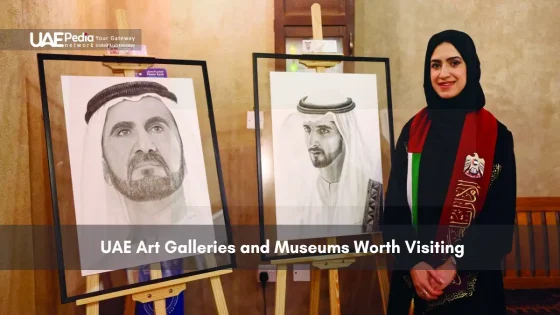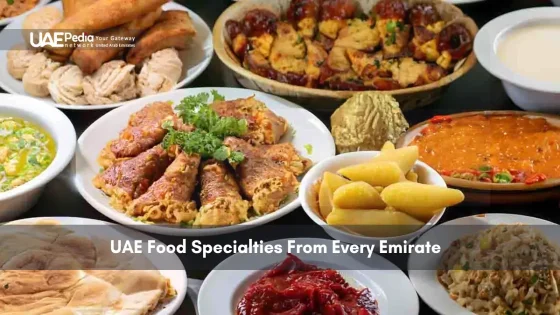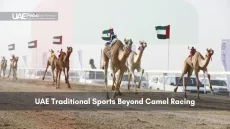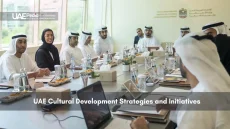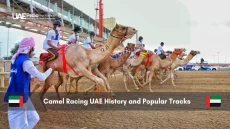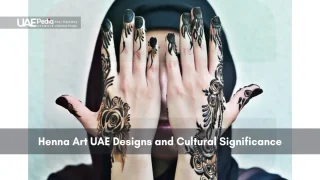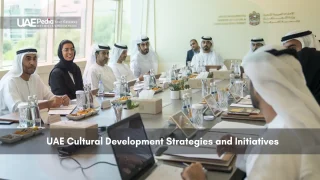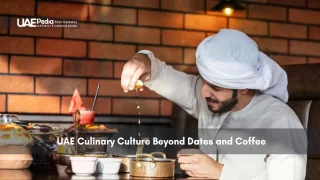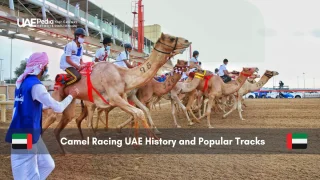What if a country could rewrite its destiny in just five decades? Since 1971, the seven emirates have woven ancient traditions with jet-age ambition—building skyscrapers where camels once roamed while keeping Bedouin hospitality alive in majlis gatherings.
Oil wealth sparked rapid growth, but the real story lies deeper. UNESCO now protects sites like Al Ain’s oases alongside Louvre Abu Dhabi’s glass dome. Falconry schools operate near AI labs. This duality defines the nation: souq spices scenting hyperloop stations, elders reciting Nabati poetry to TikTok-savvy youth.
Three elements anchor this journey:
- Rooted innovation: Palm-frond architecture inspires solar-powered cities
- Time-honored connections: Trade routes evolved into global supply chains
- Living heritage: Arabic calligraphy graces metro stations and NFT galleries
We’ll explore how pearl diving grit built financial hubs, why Emirati dialects borrow tech terms, and where you can taste saffron-infused camel milk lattes today. Ready to map this evolution?
Historical Foundations and the Federation Era
Long before skyscrapers, the desert whispered stories of resilience and community. The seven emirates’ origin story begins with nomadic Bedouin tribes whose survival depended on shared knowledge – reading stars for navigation, weaving palm fronds into homes, and passing oral histories through generations.
Early Tribal and Bedouin Influences
Archaeologists found pearl diving weights dating to 6,000 BCE along the coast – proof of ancient maritime trade. Tribal leaders gathered in majlis councils to make decisions, a practice still shaping governance today. Family networks acted as social glue, with elders preserving traditions like coffee ceremonies and falconry.
The Arrival of Foreign Nationals and Early Modernization
When foreign merchants arrived via historical trade routes, they brought new ideas without erasing local customs. Persian dhow builders taught advanced shipcraft, while Indian traders introduced spices that still flavor Emirati dishes. By the 1930s, Japanese cultured pearls forced economic reinvention – foreshadowing today’s diversification.
This blend of old and new created what historians call “adaptive heritage”. Bedouin hospitality met merchant pragmatism, forming a society ready to welcome global partners while guarding its core identity. Tribal loyalty evolved into national unity when the emirates federated in 1971, setting the stage for explosive growth.
Evolution of Emirati Cultural Heritage
How do you build a future without losing the past? The answer lies in living traditions – ancient crafts practiced in glass-walled studios, centuries-old recipes served in neon-lit food trucks. This delicate dance between preservation and progress defines the nation’s heartbeat.
Preservation of Traditional Customs
UNESCO didn’t just protect Al Ain’s 3,000-year-old oases – they turned them into classrooms. Farmers now demonstrate falaj irrigation techniques to TikTok influencers. In Sharjah’s Heart of Sharjah district, coral-stone houses host VR tours of 1950s pearl markets.
“We don’t freeze traditions in museums – we let them grow with us,” says Dr. Alia Al Mansoori, director of the Sharjah Heritage Institute.
Three pillars anchor these efforts:
- Oral history projects recording Bedouin dialects
- Government grants for artisans weaving palm-frond sadou textiles
- School programs teaching Emirati folk dances alongside robotics
Influences from Islamic, Persian, and Arab Cultures
The region’s identity layers flavors like cardamom in karak tea. Persian geometric patterns adorn Dubai Frame’s steel arches. Arab poetic meters shape hip-hop lyrics in Ras Al Khaimah’s cafes. This cultural remix birthed unique art forms:
| Influence | Traditional Form | Modern Adaptation |
|---|---|---|
| Islamic | Calligraphy | 3D-printed mosque screens |
| Persian | Wind tower architecture | Energy-efficient skyscrapers |
| Arab | Nabati poetry | Spoken-word festivals |
Friday family gatherings still feature harees (wheat-and-meat porridge) cooked over wood fires – now often Instagrammed with #HeritageBites. Private foundations like the Salama bint Hamdan Al Nahyan Foundation fund DNA studies tracing Emirati lineages, proving roots run deeper than oil wells.
UAE Cultural Transformation in the Modern Era
Imagine sipping karak tea in a driverless taxi while a holographic storyteller shares Bedouin legends. This isn’t sci-fi – it’s Dubai’s now. Cities once dotted with palm-frond huts now gleam with solar-powered towers shaped like desert flowers. Yet Friday markets still buzz with spice traders haggling over saffron, proving old rhythms thrive in new landscapes.
Digital storytellers are rewriting the rules. TikTok chefs demo machboos recipes using sous-vide cookers. Instagram poets fuse Nabati verses with AI-generated visuals. “Our grandmothers’ tales now reach millions in seconds,” notes influencer @EmiratiEats, whose date syrup challenges went viral last Ramadan.
Three innovations bridge eras:
| Tradition | Modern Twist | Impact |
|---|---|---|
| Pearl diving | VR museum exhibits | Teaches history through gaming |
| Majlis gatherings | Podcast debate series | Global audiences join discussions |
| Henna art | 3D-printed templates | Speeds designs for busy brides |
Even holiday celebrations get upgrades. Drone light shows replace fireworks during National Day, while eco-friendly palm-leaf tents host iftar feasts. The secret? “We treat change like spices – a pinch of new enhances the main flavor,” says urban planner Fatima Alremeithi.
Tomorrow’s test? Building AI cities that remember camel trails. Projects like Abu Dhabi’s Masdar City already pair wind towers with smart grids. As augmented reality adds layers to museum tours, one truth stays clear: the best futures grow from deep roots.
Impact of Globalization and Multicultural Integration
Walk through Dubai’s Gold Souk, and you’ll hear a symphony of languages before spotting a single gold necklace. Over 200 nationalities now call this desert crossroads home – a social mosaic where karak chai stands share sidewalks with Korean BBQ joints. This fusion didn’t happen by accident.
Economic Liberalization and Social Change
When the government eased trade laws in the 2000s, the world rushed in. Tax-free zones and business-friendly policies turned the region into a launchpad for global ventures. Today, 90% of residents are expats – engineers from India, chefs from Lebanon, and techpreneurs from Silicon Valley.
“Our strength lies in blending perspectives,” says Ahmed Al Jaber, a policy advisor. “Emirati ghaf trees grow taller when their roots intertwine.” Social media amplifies this mix: TikTok chefs remix luqaimat recipes with matcha powder, while local podcasts dissect K-dramas in Arabic slang.
Integration of Global Influences in Local Practices
Art Basel’s Middle East spin-off, Art Dubai, pairs Bedouin weavers with New York graffiti artists. The Louvre Abu Dhabi’s dome filters sunlight like a palm-frond roof, sheltering Da Vincis and ancient Islamic manuscripts. Even government initiatives like the Ministry of Tolerance fund projects where:
- Filipino dance troupes perform at Emirati wedding ayyas
- AI translates 14th-century Arabic poetry into 40 languages
- Global Citizen concerts raise funds for desert solar farms
At the annual World Tolerance Summit, you’ll find Buddhist monks trading stories with Bedouin elders – proof that tradition thrives when it travels. As one Dubai resident quips: “Our majlis now has seats for every continent.”
Rise of Cultural Institutions and Vibrant Events
Picture this: a sand-colored fortress turned time machine, where pearl diving tools sit beside holographic maps. Across the nation, spaces like these pulse with stories – not just preserving the past, but remixing it for tomorrow’s crowds.
Museums, Heritage Sites, and UNESCO Recognitions
Dubai Museum’s 1787 Al Fahidi Fort now lets you smell frankincense from ancient trade routes. Over in Abu Dhabi, the Louvre’s rain-of-light dome shelters Monet’s water lilies and 7th-century Quranic manuscripts. UNESCO stamps protect more than sites – they guard living traditions:
| Heritage Site | Ancient Role | Modern Twist |
|---|---|---|
| Al Ain Oases | Date palm farming | Solar-powered irrigation demos |
| Sharjah Art District | Pearl trading hub | Street art murals by global creators |
| Hili Archaeological Park | Bronze Age tombs | AR-guided storytelling tours |
Emergence of Art, Music, and Festival Culture
Abu Dhabi’s Saadiyat Island now rivals Paris’ Left Bank. The opera house stages Emirati zar folk dances alongside Broadway hits. “Our stages have no borders,” says violinist Eman Al Hashimi, who blends oud strings with synth beats.
Festival math looks like this:
- Art Dubai = 500+ artists × robot painters
- Sharjah Biennial = 150 installations + VR poetry slams
- Dubai Jazz Fest = smooth sax solos + Bedouin drum circles
Private galleries partner with schools to turn students into curators. Government grants help chefs reinvent balaleet (sweet vermicelli) as festival food truck hits. When the sun sets, laser shows dance across 12th-century watchtowers – proof that heritage loves good company.
Traditional Practices in a Rapidly Modernizing Society
Step into an Emirati home today, and you’ll find Wi-Fi passwords scribbled next to hand-painted dallah coffee pots. Even as smart cities rise, time-honored customs thrive – like morning coffee rituals where elders pour bitter gahwa into porcelain cups, their wrists tilted just so. These practices aren’t relics – they’re living threads woven into the country’s hyper-connected present.
The dallah pot remains a social anchor. Serving coffee first to the eldest guest, refilling cups three times, using cloves or cardamom – each gesture carries generations of meaning. “It’s our silent language of respect,” says coffee master Khalid Al Marri, whose Dubai café trains baristas in both latte art and Bedouin etiquette.
Urban life races forward, but neighborhoods preserve quiet rhythms. Families still gather weekly for majlis talks under date palm shades. Artisans stitch sadou patterns into designer handbags sold via Instagram. Storytellers spin tales of pearl divers to wide-eyed kids – sometimes via podcast mics now.
Three ways traditions adapt:
- Craft revival: Weavers use natural dyes for luxury hotels while teaching workshops
- Ritual remix: Wedding henna parties stream globally via Zoom
- Taste bridges: Date syrup sweetens artisanal gelato in Abu Dhabi’s food trucks
Communities balance progress and heritage through shared efforts. Neighborhood councils maintain fishing net repair skills listed in historical legal systems, while schools host robot-building camps. As architect Amna Al Falasi notes: “Our homes hold the past close so we can leap forward unafraid.”
The country’s secret? Treating tradition like a compass – not an anchor. Skyscrapers may pierce clouds, but below, grandmothers still knead dough for khameer bread. Innovation fuels the economy, but family bonds fuel the soul.
Gender Roles and Family Dynamics in Emirati Society
What shapes a family’s heartbeat in a land where tradition meets hyper-speed progress? For generations, households thrived on clear roles: men as providers navigating desert trades, women as anchors preserving Emirati culture through storytelling and kinship. Today, coffee pots simmer beside laptop chargers as new rhythms emerge.
Traditional Family Structures and Roles
Grandfathers once led majlis discussions while grandmothers orchestrated Friday feasts. Sons learned pearl diving or falconry; daughters mastered embroidery and hospitality codes. These patterns ensured survival in harsh climates. “Respect for elders remains our compass,” shares Alia Al Mazrouei, a third-generation teacher in Abu Dhabi.
The Evolving Role of Women in Society
Change arrived with school buses and smartphones. Nearly half of working-age women now contribute to the economy – up from 23% in 1975. The UAE government fuels this shift through policies like:
- Mandatory female board members in public companies
- Maternity leave extensions to 90 days
- STEM scholarships for girls
Young mothers today juggle careers and cultural duties. At Sharjah’s festivals, you’ll see engineers in abayas explaining AI to wide-eyed girls. As regional shifts ripple through the Arab world, families debate screen time versus storytelling nights. Yet weekly gatherings still begin with three kisses on the cheek – an unbroken chain of belonging.
“We write new chapters without erasing the old,” says Noura Al Kaabi, Minister of Community Development. “Our grandmothers’ wisdom guides skyscrapers’ blueprints.”
Balancing Modernity and Cultural Preservation
Walking this tightrope requires vision – building rocket pads without burying date palm roots. Here, progress means layering rather than replacing. The secret sauce? Strategic partnerships where tradition fuels innovation.
The Role of Government Initiatives
Vision 2021 acts as the playbook, funding projects that turn heritage into living labs. Take the National Strategy for Cultural Heritage – it’s not just preserving forts, but training youth to 3D-map ancient irrigation systems. Communities play a key part, with elders advising tech teams on restoring coral-stone architecture.
Three standout programs blend old and new:
| Initiative | Focus | Outcome |
|---|---|---|
| Creative Talent Exchange | Weavers + architects | Palm-frond inspired mall designs |
| Living Libraries Program | Oral histories + AI | Voice-activated story walls |
| Festival Accelerator Fund | Local artists + global stages | #1 UNESCO creative city cluster |
Annual events like the Dubai Heritage Festival now draw 40% international visitors – proof that values can be both preserved and exported. “We’re coding tradition into tomorrow’s DNA,” says program director Marwan Al Naqbi, whose team streams camel races in VR.
Neighboring countries now replicate these models. Saudi Arabia’s Diriyah Gate project mirrors Abu Dhabi’s Qasr Al Hosn restoration tactics. By making communities active partners rather than museum pieces, the approach keeps roots alive while branches reach new heights.
Reflections on the Journey of Emirati Cultural Evolution
In the shadow of towering glass spires, elders still gather to share stories under the stars—proof that some roots grow deeper with time. Five decades of visionary efforts have crafted a place where heritage fuels innovation like desert winds powering solar farms. From federation-era diplomacy to AI-powered museums, each generation adds new layers to the national story.
Urban city rhythms now dance with timeless customs. Morning commuters pass souq spice stalls unchanged for centuries. Evening events might feature holographic poets reciting Nabati verse—a way of honoring tradition while rewriting its rules. This blend didn’t happen by chance. Strategic initiatives turned palm-frond weaving into sustainable architecture and pearl diving tales into VR classrooms.
Young Emiratis today inherit a lifestyle balancing smart tech with ancestral wisdom. Grandmothers teach grandchildren to pour gahwa coffee through TikTok filters. Entrepreneurs mint NFTs of coral-stone patterns. It’s this fluid culture—neither frozen nor forgotten—that makes the region an example for rapidly modernizing societies worldwide.
As the future unfolds, one truth remains: progress here means building taller without cutting ties to the ground. The nation also shows how identity thrives when communities co-author change. Whether you’re sipping karak tea in a driverless cab or tracing ancient trade routes through blockchain maps, you’re witnessing a living blueprint—a place where every generation bridges what was and what’s next.
Think of it like a carefully brewed karak chai—blending bold flavors with modern twists. The UAE government supports heritage through initiatives like Al Shindagha Museum in Dubai, while embracing innovation (hello, Louvre Abu Dhabi!). Families often gather in majlis spaces to share stories, ensuring customs thrive alongside futuristic cityscapes.
Emirati women are like the intricate patterns in Sadu weaving—essential to the nation’s fabric. From leading space missions to curating art exhibitions at Sharjah Art Foundation, they redefine roles while honoring traditions. Government policies like gender-balanced cabinets amplify their voices in national dialogues.
Imagine the UAE as a crossroads of civilizations. Persian pearl trading, Indian spice routes, and East African rhythms left marks on cuisine, music, and architecture. Today, global events like Dubai Design Week fuse these layers with contemporary creativity—without erasing Emirati roots.
Start by learning a few Arabic phrases—"Marhaba" (hello) opens doors. Attend camel races or Liwa Date Festival to witness living traditions. When visiting heritage sites like Al Ain Oasis, follow local etiquette: dress modestly, ask before photographing people, and try gahwa (coffee) served with dates.
It’s the mix of scale and intimacy. Abu Dhabi Cultural Foundation’s Hayy Jameel events feel like neighborhood gatherings, while Dubai Shopping Festival dazzles with global spectacle. Look for UNESCO-recognized practices like Al Taghrooda poetry during Ramadan—a blend of ancient art and modern stages.
Yes, but think evolution, not revolution. Multigenerational homes remain common, yet young Emiratis balance tech careers with Friday family lunches. Government housing projects like Barari in Abu Dhabi design spaces for both privacy and communal majlis gatherings, reflecting shifting needs.
